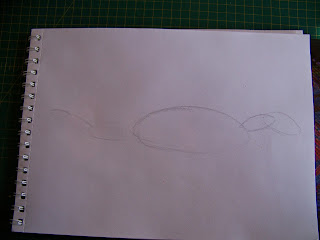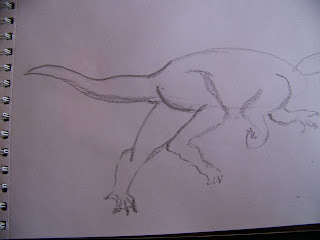I am not at all into dinosaurs. This is such a well-established fact that my family members all reacted with astonishment when they saw the subject for today's blog. So why draw a dinosaur? Because I have a little nephew who is enchanted by these huge monsters, and I bet many of you have a child like that in your lives as well. And so we draw dinosaurs! This drawing may appear very intricate, but it is one of the easiest animal drawings I have ever done. I break the process down into steps and walk you through it slowly. Even if you know nothing about drawing, you should be able to master this.
I start with a drawing pad and 2B pencil. I slip a piece of cardboard underneath the page I am using to protect the pages beneath this one from indentations should I press down hard with a pencil.
I start with a nice big oval in the center of my page. This will be the body of the dinosaur.
I add two more ovals to the front for the neck and the face. These are substantially smaller than the first oval.
Three more ovals at the back gives shape to the curved tail.
With the main shapes in place I start shaping the front leg closest to us.
I add a curved foot.
The furthest front leg is added with its claw-like features. I add nails to the first leg as well.
Now I shape the hind leg closest to us.
I spend a while on shaping the hind foot with its claws/toes.
Now I add the far hind leg.
The only reason this dinosaur does not topple over on its head, is because it balances its weight with its tail. It is important that you make the viewers believe this when you shape the tail. Make it long and thick.
I finally shape the curve of the body.
I now move on to the top of the neck and head. Get the bumps for the eyes and ears and nose in the right place.
Add the detail and shadows that will give shape to the face.
I draw the bottom line for the lower jaw.
Add the teeth and tongue to complete the mouth.
The bottom of the neck and torso is given shape.
I define the short line that is the only part of the stomach that is visible. I then use a soft eraser to get rid of any excess lines.
I add more defining lines for muscle and bone structure. It also gives visual clues to the texture of the skin.
Continuing the process of adding definition to the front body.
Adding definition to the back.
I take my time on the two strong back legs. The viewer has to believe that these strong legs can carry the weight of the dinosaur.
I am satisfied that everything is in place at the right proportion.
The dinosaur can not float in space. I ground it with a few pebbles/rocks.
I add a mountain range in the background. This is the first visual clue the viewer gets as to the size of the dinosaur. If it were smaller, the distant mountains would still be higher than the head of the dinosaur. We are looking up at the dinosaur, leaving us enough space to see the distant mountains behind the dinosaur.
The mountains and hills are defined.
The position of the clouds is a second visual cue as to proportion/size of the dinosaur.
The third visual cue the viewers receive about the size of the dinosaur are the palm trees in the background.
The drawing is complete and it is time to add color. I use Derwent Drawing pencils because I love the colors for this project.
I add Smoke Blue to the clouds.
Ink Blue is added to the dark areas in the clouds.
Chinese white is used to blend the clouds.
The air is colored with Cool Grey.
The air is always at its lightest at the horizon as a result of light hitting the earth there and reflecting back. I color the horizon's Cool Grey with Chinese White to lighten it.
Green Shadow is used to color the palm trees.
Warm Earth creates shadow in the palm trees.
Smoke blue is added to the right hand of the mountain tops. This establishes the light source as coming from the left.
Crag Green is added to the mountains.
Yellow Ochre adds light to the mountains.
Brown Ochre completes the mountains and moves down to the foreground.
Olive Earth is added to the foreground.
The rocks are laid down in Chocolate.
The light side of the rocks are colored in Terracotta.
The tops of the rocks are shaded in Wheat.
The deep shadow areas of the dinosaur is colored in Olive Earth.
Green Shadow is added to the lighter areas on the dinosaur.
Pale Cedar fills the remaining gaps on the dinosaur.
I use a paper stump to blend the colors on the dinosaur. Here I have started on the tail. Can you see the difference it makes to the drawing?
The finished product.
For more crafty ideas and great products, visit APrettyTalent.com.
Remember to keep nurturing your TALENT for making PRETTY things.
You can subscribe to this blog and receive regular updates by email by simply registering your email address at the top of the current blog.

















































No comments:
Post a Comment